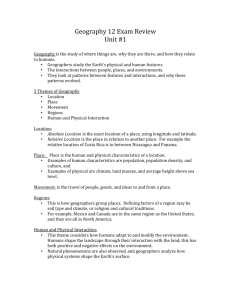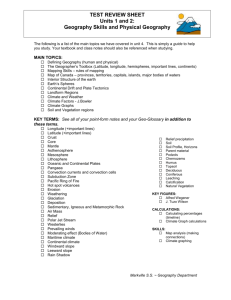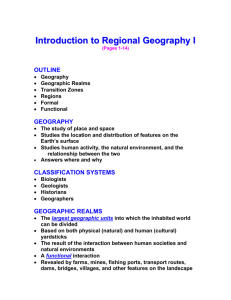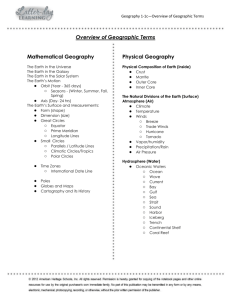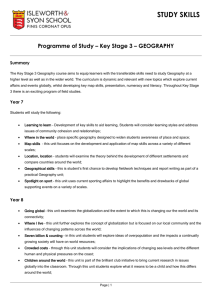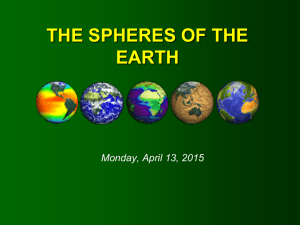On-Line Study Guide
advertisement
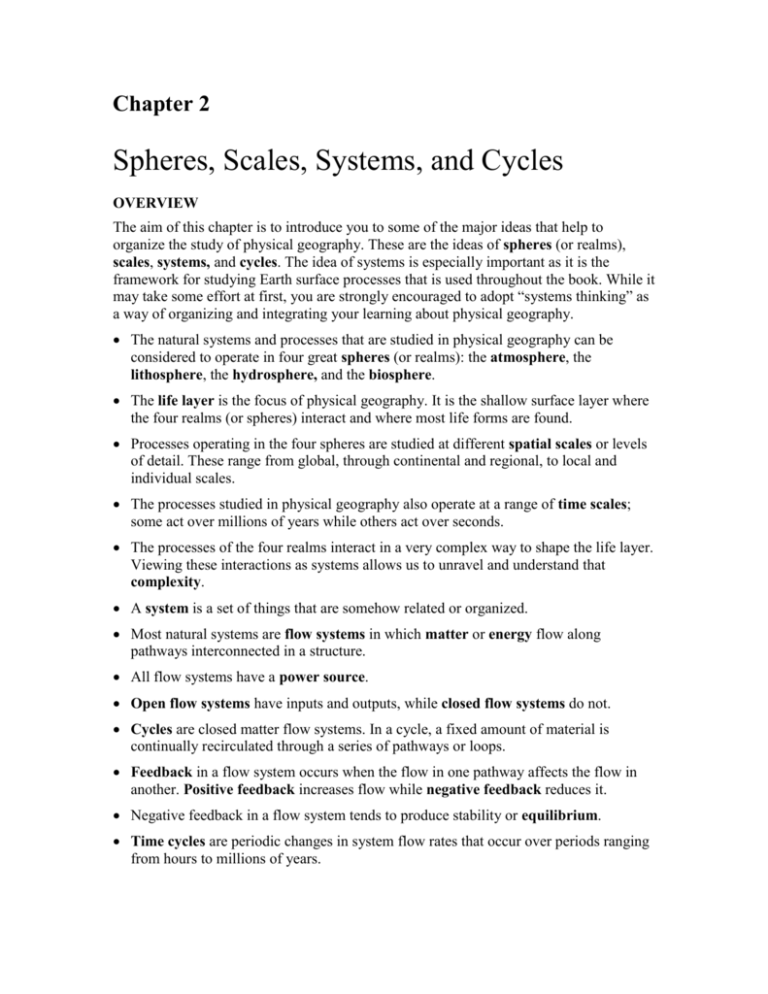
Chapter 2 Spheres, Scales, Systems, and Cycles OVERVIEW The aim of this chapter is to introduce you to some of the major ideas that help to organize the study of physical geography. These are the ideas of spheres (or realms), scales, systems, and cycles. The idea of systems is especially important as it is the framework for studying Earth surface processes that is used throughout the book. While it may take some effort at first, you are strongly encouraged to adopt “systems thinking” as a way of organizing and integrating your learning about physical geography. The natural systems and processes that are studied in physical geography can be considered to operate in four great spheres (or realms): the atmosphere, the lithosphere, the hydrosphere, and the biosphere. The life layer is the focus of physical geography. It is the shallow surface layer where the four realms (or spheres) interact and where most life forms are found. Processes operating in the four spheres are studied at different spatial scales or levels of detail. These range from global, through continental and regional, to local and individual scales. The processes studied in physical geography also operate at a range of time scales; some act over millions of years while others act over seconds. The processes of the four realms interact in a very complex way to shape the life layer. Viewing these interactions as systems allows us to unravel and understand that complexity. A system is a set of things that are somehow related or organized. Most natural systems are flow systems in which matter or energy flow along pathways interconnected in a structure. All flow systems have a power source. Open flow systems have inputs and outputs, while closed flow systems do not. Cycles are closed matter flow systems. In a cycle, a fixed amount of material is continually recirculated through a series of pathways or loops. Feedback in a flow system occurs when the flow in one pathway affects the flow in another. Positive feedback increases flow while negative feedback reduces it. Negative feedback in a flow system tends to produce stability or equilibrium. Time cycles are periodic changes in system flow rates that occur over periods ranging from hours to millions of years. Studying the systems of the life layer and their interactions leads to a better understanding of the human habitat, environmental problems, and global change. KEY TERMS Earth realms atmosphere lithosphere hydrosphere biosphere life layer scale systems flow system pathways structure input output power source open flow system closed flow system cycle material cycle feedback equilibrium time cycle STUDY QUESTIONS 1. Spheres, scales, systems, and cycles are four overarching ideas used to organize the study of physical geography. What are these ideas and why do you think they are useful to physical geographers? 2. Name and define the four great spheres (or realms) of the Earth. 3. Why is it important to know that different processes operate at different space and time scales? 4. Give two examples of a system or process that you might see operating at each of the global, continental, regional, local, and individual scales. 5. What is a flow system and what are its key components? 6. What is the difference between an open and a closed flow system? What is the difference between a matter and an energy flow system? 7. Give an example of a cycle that might be studied in physical geography and describe its operation in system terms. 8. How do the concepts of feedback and equilibrium apply to systems? Illustrate your answer with an example of a natural system. 9. What is a time cycle as applied to a system? Give an example of a time cycle in a natural system. 10. Why is systems thinking is useful to scientists and to physical geographers in particular? CHAPTER QUIZ Multiple Choice Questions 1. The pattern of soils and vegetation within a river valley would be studied at a: a) global scale b) continental scale c) regional scale d) local scale 2. The impact of climate change on ocean currents would be studied at a: a) global scale b) continental scale c) regional scale 3. 4. 5. 6. d) local scale Rivers and lakes are part of the: a) atmosphere b) lithosphere c) hydrosphere d) biosphere The most important power source for the natural systems of the life layer is: a) gravity b) magnetism c) solar radiation d) inertia Energy flow systems are: a) always open b) always closed c) both open and closed at different times d) open or closed depending on where we draw the boundary around the system Which of the following is an example of a time cycle? a) ocean tides b) seasons c) both (a) and (b) d) neither (a) nor (b) True/False Questions 1. The lithosphere is the outermost solid layer of the Earth. (T/F) 2. Systems that come to an equilibrium are normally stabilized by positive feedback. (T/F) 3. The hydrological cycle is an example of an open flow system. (T/F) Short Answer Questions 1. What is the biosphere? 2. What distinguishes a cycle or closed flow system from an open flow system? 3. What is the difference between positive and negative feedback? Short Essay Questions (1 - 2 paragraphs) 1. What is the “life layer” and how is it related to the four great realms, or spheres, of the Earth? 2. A river flowing into the ocean is an example of a natural, open material flow system. Describe the components of the system including its pathways, inputs and outputs, and positive or negative feedback mechanisms. Internet Resources 1. An internet exercise reviewing terms used in system flow diagrams: <http://www.bbc.co.uk/education/gcsebitesize/geography/exam_skills/flow_diagrams _rev.shtml> 2. An internet slide show introducing system concepts in geography: <http://www.millersv.edu/~geograph/steve/230/systems/> 3. A slide show on the Digital Earth initiative that provides views of the Earth at different scales or levels of detail: <http://digitalEarth.gsfc.nasa.gov/NASAbriefing/> 4. The International Geosphere-Biosphere Programme – An inter-disciplinary, global study of links between the great realms of the Earth: <http://www.igbp.kva.se/cgibin/php/frameset.php> 5. Essays on scaling issues in global environmental change research: <http://www.gcrio.org/ASPEN/science/EOC97/eoc97misc/toc.html>

